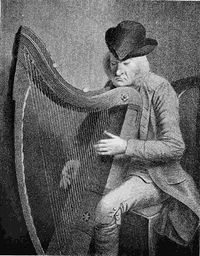Annotation:Love is a Tormenting Pain: Difference between revisions
No edit summary |
No edit summary |
||
| (7 intermediate revisions by 2 users not shown) | |||
| Line 11: | Line 11: | ||
{{break}} | {{break}} | ||
[[File:Denis Hempson.jpg|200px|thumb|left|Denis Hempson]] | [[File:Denis Hempson.jpg|200px|thumb|left|Denis Hempson]] | ||
'''LOVE IS A TORMENTING PAIN''' ("An Cuac Deas" or "Is Galar Cráidhte an Grádh"). | '''LOVE IS A TORMENTING PAIN''' ("An Cuac Deas" or "Is Galar Cráidhte an Grádh"). AKA - "[[Mo chreach is mo dhith is claoidhte an galar an gradh]]." Air (3/4 time, "tenderly"). F Major. Standard tuning (fiddle). AAB. The Irish collector Edward Bunting states in his 1840 '''Ancient Music of Ireland''' (p. 44) that the tune was a composition from the year 1670 of the harper-composer William Connellan, whose more famous brother was the musician Thomas Connellan, although Bunting's own MS notes seem to suggest it was originally called the "[[Golden Hero]]." The Stanford-Petrie collection (1905) contains a tune entitled "[[Mo chreach is mo dhith is claoidhte an galar an gradh]]" (No. 1573), a version of this melody. O'Neill's version seems taken directly from Bunting, although he inexplicably credits himself (or his collaborator James O'Neill) for the version in '''Music of Ireland''' (1903). | ||
{{break|2}} | {{break|2}} | ||
The complete lyrics of : "''A Pretty New Song of Nancies Unkindness to her Lover. To its own propper Tune: True Love is a Tormenting Pain''", can be found in the archive of the National Library of Scotland Ry.III.a.10(020) '' | The complete lyrics of : "''A Pretty New Song of Nancies Unkindness to her Lover. To its own propper Tune: True Love is a Tormenting Pain''", can be found in the archive of the National Library of Scotland Ry.III.a.10(020) <font face="sans-serif" size="2">''(credit: [http://irishsongproject.qub.ac.uk/song/182 The Irish Song Project)''</font> <ref>The National Library of Scotland estimates the first printing of this ballad to have been c.1701. None of the major ballad sheet archives show evidence of an Irish printing. The tune was collected for Bunting around 1800 and clearly shows the characteristically peripetetic movement of songs between localities.</ref> ]:[[File:True Love's a Tormenting Pain.jpg|thumb|right|True Love's a Tormenting Pain facsimile - ''source:'' [http://irishsongproject.qub.ac.uk/song/182 The Irish Song Project]]] | ||
<blockquote> | <blockquote> | ||
As I was a ranging yon Forrest of Fancies,{{break}} | ''As I was a ranging yon Forrest of Fancies,{{break}} | ||
With the nine Muses attending me,{{break}} | ''With the nine Muses attending me,{{break}} | ||
Into a Bour I spyed a beautiful Nancie,{{break}} | ''Into a Bour I spyed a beautiful Nancie,{{break}} | ||
Sadly bemoaning her Destinie;{{break}} | ''Sadly bemoaning her Destinie;{{break}} | ||
Saying Alas! Where shall I wander,{{break}} | ''Saying Alas! Where shall I wander,{{break}} | ||
Where to find out my own dear Swain,{{break}} | ''Where to find out my own dear Swain,{{break}} | ||
Patience of Sorrow in heart I lay under,{{break}} | ''Patience of Sorrow in heart I lay under,{{break}} | ||
''True love is a Tormenting pain.''{{break|2}} | ''True love is a Tormenting pain.''{{break|2}} | ||
{{break|8}} | |||
''But when I consider the promise I made him{{break}} | |||
{{break| | ''That I would ever be Just and True,{{break}} | ||
But when I consider the promise I made him{{break}} | ''But now since I find I have betray'd him,{{break}} | ||
That I would ever be Just and True,{{break}} | ''This doth my a Sorrows fresh renew,{{break}} | ||
But now since I find I have betray'd him,{{break}} | ''Every Night instead of Sleeping,{{break}} | ||
This doth my a Sorrows fresh renew,{{break}} | ''Tiers I do shed like showers of Rain,{{break}} | ||
Every Night instead of Sleeping,{{break}} | ''My heart would break if it were not foreweeping {{break}} | ||
Tiers I do shed like showers of Rain,{{break}} | |||
My heart would break if it were not foreweeping {{break}} | |||
''True love is a tormenting pain'' | ''True love is a tormenting pain'' | ||
</blockquote> | </blockquote> | ||
Latest revision as of 23:46, 22 January 2020
X:1 T:Love’s a Tormenting Pain M:3/4 L:1/16 R:Air C:”W. Connallon 1670” B:Bunting – Ancient Music of Ireland (1840, No. 60, p. 44) Z:AK/Fiddler’s Companion K:F "Tenderly and Gracefully"[F4A4c4]-|[F4B4d4] c3d f4|{E}.F4-.F4 F/G/A3|c4 (d2c2) (A2G2)|[F8A8] [F4c4]| [F4d4] (c3d) f4|{E}.F4.F4~G4|{FG}A8 (G/F/E3)|F8:| |:.c4|.c4 [F4A4c4] (d3e)|f8a4|f8 e4|d8 c4|c4 (d2c2)(A2c2)| d4 (c3d)(e3d)|(.e4.c4.c4)|c8 (3c2d2e2|(.f4.e4.d4)|(.c4.B4.A4)| G4 A3G F4|[F8A8] [F4c4]|[F4B4d4] (c3e) .f4]|{E}(.F4.F4.G4)|[F8A8]TG4|[C8F8]||

LOVE IS A TORMENTING PAIN ("An Cuac Deas" or "Is Galar Cráidhte an Grádh"). AKA - "Mo chreach is mo dhith is claoidhte an galar an gradh." Air (3/4 time, "tenderly"). F Major. Standard tuning (fiddle). AAB. The Irish collector Edward Bunting states in his 1840 Ancient Music of Ireland (p. 44) that the tune was a composition from the year 1670 of the harper-composer William Connellan, whose more famous brother was the musician Thomas Connellan, although Bunting's own MS notes seem to suggest it was originally called the "Golden Hero." The Stanford-Petrie collection (1905) contains a tune entitled "Mo chreach is mo dhith is claoidhte an galar an gradh" (No. 1573), a version of this melody. O'Neill's version seems taken directly from Bunting, although he inexplicably credits himself (or his collaborator James O'Neill) for the version in Music of Ireland (1903).

As I was a ranging yon Forrest of Fancies,
With the nine Muses attending me,
Into a Bour I spyed a beautiful Nancie,
Sadly bemoaning her Destinie;
Saying Alas! Where shall I wander,
Where to find out my own dear Swain,
Patience of Sorrow in heart I lay under,
True love is a Tormenting pain.
But when I consider the promise I made him
That I would ever be Just and True,
But now since I find I have betray'd him,
This doth my a Sorrows fresh renew,
Every Night instead of Sleeping,
Tiers I do shed like showers of Rain,
My heart would break if it were not foreweeping
True love is a tormenting pain
